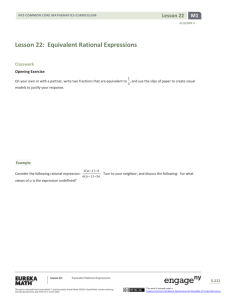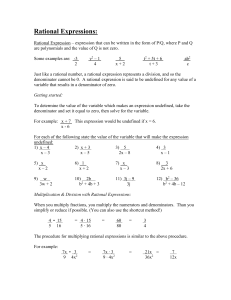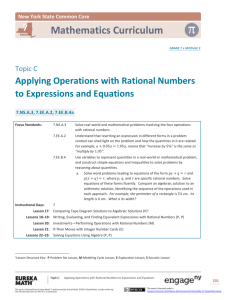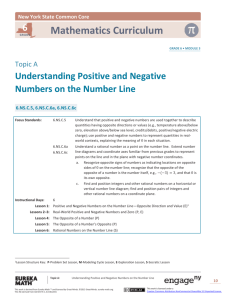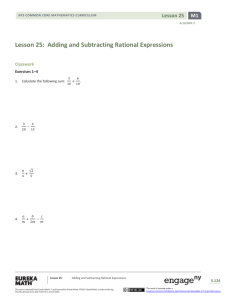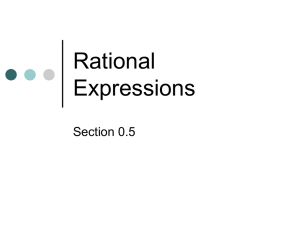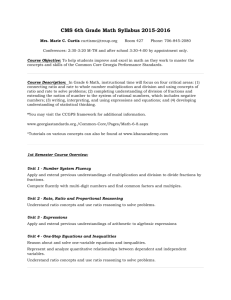Lesson 23: Comparing Rational Expressions
advertisement
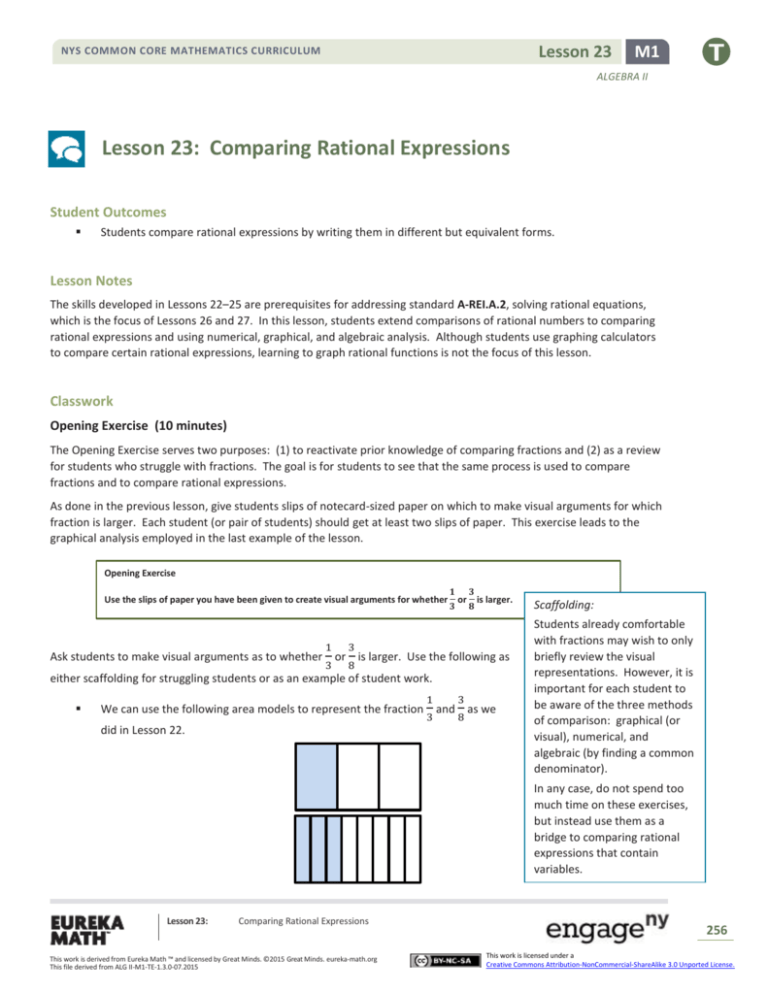
Lesson 23 NYS COMMON CORE MATHEMATICS CURRICULUM M1 ALGEBRA II Lesson 23: Comparing Rational Expressions 20 Student Outcomes Students compare rational expressions by writing them in different but equivalent forms. Lesson Notes The skills developed in Lessons 22–25 are prerequisites for addressing standard A-REI.A.2, solving rational equations, which is the focus of Lessons 26 and 27. In this lesson, students extend comparisons of rational numbers to comparing rational expressions and using numerical, graphical, and algebraic analysis. Although students use graphing calculators to compare certain rational expressions, learning to graph rational functions is not the focus of this lesson. Classwork Opening Exercise (10 minutes) The Opening Exercise serves two purposes: (1) to reactivate prior knowledge of comparing fractions and (2) as a review for students who struggle with fractions. The goal is for students to see that the same process is used to compare fractions and to compare rational expressions. As done in the previous lesson, give students slips of notecard-sized paper on which to make visual arguments for which fraction is larger. Each student (or pair of students) should get at least two slips of paper. This exercise leads to the graphical analysis employed in the last example of the lesson. Opening Exercise 𝟏 𝟑 𝟑 𝟖 Use the slips of paper you have been given to create visual arguments for whether or 1 3 3 8 is larger. Ask students to make visual arguments as to whether or is larger. Use the following as either scaffolding for struggling students or as an example of student work. 1 3 3 8 We can use the following area models to represent the fraction and as we did in Lesson 22. Scaffolding: Students already comfortable with fractions may wish to only briefly review the visual representations. However, it is important for each student to be aware of the three methods of comparison: graphical (or visual), numerical, and algebraic (by finding a common denominator). In any case, do not spend too much time on these exercises, but instead use them as a bridge to comparing rational expressions that contain variables. Lesson 23: Comparing Rational Expressions This work is derived from Eureka Math ™ and licensed by Great Minds. ©2015 Great Minds. eureka-math.org This file derived from ALG II-M1-TE-1.3.0-07.2015 256 This work is licensed under a Creative Commons Attribution-NonCommercial-ShareAlike 3.0 Unported License. Lesson 23 NYS COMMON CORE MATHEMATICS CURRICULUM M1 ALGEBRA II 1 3 We see that these visual representations of the fractions give us strong evidence that Discuss with your neighbor another way to make a comparison between the two fractions and why we might not want to always rely on visual representations. 3 < . 8 Students should suggest finding decimal approximations of fractions and converting the fractions to equivalent fractions with common denominators. Reasons for not using visual representations may include the difficulty with fractions with large denominators. Once students have had a chance to discuss alternative methods, ask them to choose one of the two methods to verify that the visual representations above are accurate. Common denominators: We have 1 3 1 3 ≈ 0.333 and = 8 24 and 3 8 = 3 8 = 0.375; thus, 9 24 . Since 8 24 < 1 3 9 3 < . 8 , we know that 24 1 3 3 < . 8 Discuss with your partner the pros and cons of both methods before discussing as a class. Decimal approximations: We have Decimal approximations are quick with a calculator but may take a while if long division is needed. Many students prefer decimals to fractions, but they use approximations of the numbers instead of the exact values of the numbers. Common denominators use the actual numbers but require working with fractions. Just as we can determine whether two rational expressions are equivalent in a similar way as we can with rational numbers, we can extend our ideas of comparing rational numbers to comparing rational expressions. Exercises (11 minutes) As students work on Exercises 1–5, circulate through the class to assess their understanding. Exercises We will start by working with positive integers. Let 𝒎 and 𝒏 be positive integers. Work through the following exercises with a partner. 1. Fill out the following table. 𝒏 𝟏 𝒏 𝟏 𝟏 𝟐 𝟑 𝟒 𝟓 𝟔 Lesson 23: Comparing Rational Expressions This work is derived from Eureka Math ™ and licensed by Great Minds. ©2015 Great Minds. eureka-math.org This file derived from ALG II-M1-TE-1.3.0-07.2015 𝟏 𝟐 𝟏 𝟑 𝟏 𝟒 𝟏 𝟓 𝟏 𝟔 257 This work is licensed under a Creative Commons Attribution-NonCommercial-ShareAlike 3.0 Unported License. Lesson 23 NYS COMMON CORE MATHEMATICS CURRICULUM M1 ALGEBRA II 2. Do you expect 𝟏 𝒏 to be larger or smaller than From the table, as 𝒏 increases, 𝟏 𝒏 3. > 𝟏 𝒏+𝟏 > 𝟏 𝟏 𝒏 𝟏 ? Do you expect 𝒏+𝟏 𝟏 𝒏 to be larger or smaller than decreases. This means that since 𝟏 + 𝒏 > 𝒏, we will have 𝟏 𝟏+𝒏 𝟏 ? Explain why. 𝒏+𝟐 𝟏 < . That is, 𝒏 . 𝒏+𝟐 𝟏 Compare the rational expressions , 𝟏 , and 𝒏 𝒏+𝟏 𝟏 𝒏+𝟐 for 𝒏 = 𝟏, 𝟐, and 𝟑. Do your results support your conjecture from Exercise 2? Revise your conjecture if necessary. For 𝒏 = 𝟏, 𝟏 𝒏 = 𝟏, 𝟏 𝒏+𝟏 𝟏 𝟏 𝟐 𝒏+𝟐 = , and 𝟏 = , and we know 𝟏 > 𝟑 𝟏 𝟏 𝟏 𝟏 𝟐 𝟑 𝟒 𝟐 𝟏 𝟏 𝟏 𝟏 𝟑 𝟒 𝟓 𝟑 For 𝒏 = 𝟐, we have , , and , and we know For 𝒏 = 𝟑, we have , , and , and we know This supports the conjecture that 4. 𝟏 > 𝒏 𝟏 𝒏+𝟏 > > > 𝟏 𝟏 𝟑 𝟏 𝟒 𝟏 𝟏 > . 𝟐 𝟑 𝟏 > . 𝟒 𝟏 > . 𝟓 . 𝒏+𝟐 From your work in Exercises 1 and 2, generalize how 𝟏 𝒏 compares to 𝟏 , where 𝒎 and 𝒏 are positive integers. 𝒏+𝒎 Since 𝒎 is a positive integer being added to 𝒏, the denominator will increase, which will decrease the value of the rational expression overall. That is, 5. 𝟏 𝒏 > 𝟏 𝒏+𝒎 for positive integers 𝒎 and 𝒏. Will your conjecture change or stay the same if the numerator is 𝟐 instead of 𝟏? Make a conjecture about what happens when the numerator is held constant, but the denominator increases for positive numbers. It will stay the same because this would be the same as multiplying the inequality by 𝟐, and multiplication by a positive number does not change the direction of the inequality. If the numerator is held constant and the denominator increases, you are dividing by a larger number, so you get a smaller number overall. Example (11 minutes) Suppose we want to compare the values of the rational expressions 𝑥+1 𝑥 and 𝑥+2 𝑥+1 for positive values of 𝑥. What are some ways to do this? Ask students to suggest some methods of comparison. If needed, guide them to the ideas of using a numerical comparison through a table of values and a graphical comparison of the related rational functions 𝑦 = 𝑥+1 𝑥+2 and 𝑦 = 𝑥 𝑥+1 for 𝑥 > 0. Let’s start our comparison of Lesson 23: 𝑥+1 𝑥 and 𝑥+2 𝑥+1 by looking at a table of values. Comparing Rational Expressions This work is derived from Eureka Math ™ and licensed by Great Minds. ©2015 Great Minds. eureka-math.org This file derived from ALG II-M1-TE-1.3.0-07.2015 258 This work is licensed under a Creative Commons Attribution-NonCommercial-ShareAlike 3.0 Unported License. Lesson 23 NYS COMMON CORE MATHEMATICS CURRICULUM M1 ALGEBRA II Have students complete the table below using their calculators and rounding to four decimal places. Example 𝒙 𝒙+𝟏 𝒙 𝒙+𝟐 𝒙+𝟏 𝟎. 𝟓 𝟑 𝟏. 𝟔𝟔𝟔𝟕 𝟏 𝟐 𝟏. 𝟓𝟎𝟎𝟎 𝟏. 𝟓 𝟏. 𝟔𝟔𝟔𝟕 𝟏. 𝟒𝟎𝟎𝟎 𝟐 𝟏. 𝟓 𝟏. 𝟑𝟑𝟑𝟑 𝟓 𝟏. 𝟐 𝟏. 𝟏𝟔𝟔𝟕 𝟏𝟎 𝟏. 𝟏 𝟏. 𝟎𝟗𝟎𝟗 𝟏𝟎𝟎 𝟏. 𝟎𝟏 𝟏. 𝟎𝟎𝟗𝟗 Discussion From the table of values, it appears that 𝑥+1 𝑥 > 𝑥+2 𝑥+1 for positive values of 𝑥. However, we have only checked 7 values of 𝑥, so we cannot yet say that this is the case for every positive value of 𝑥. How else can we compare the values of these two expressions? Students should suggest graphing the functions 𝑦 = Have students graph the two functions 𝑦 = 𝑥+1 𝑥+2 and 𝑦 = . 𝑥 𝑥+1 𝑥+1 𝑥+2 and 𝑦 = on their 𝑥 𝑥+1 calculators, and ask them to share their observations. Does the graph verify the conclusions we drew from the table above? 𝑦= 𝑥+1 𝑥 It seems from both the table of data and from the graph that 𝑥+1 𝑥 > 𝑥+2 𝑥+1 𝑦= for positive values of 𝑥, but we have not shown it 𝑥+2 𝑥+1 conclusively. How can we use algebra to determine if this inequality is always true? We want to compare 𝑥+1 𝑥 and 𝑥+2 . 𝑥+1 Ask students what they need to do before comparing fractions such as 2 3 8 and . Wait for someone to suggest that they need to find a common 7 denominator. Let’s take a step back and see how we would compare the two fractions 3 8 2 and . First, we find the common 7 denominator. Lesson 23: Comparing Rational Expressions This work is derived from Eureka Math ™ and licensed by Great Minds. ©2015 Great Minds. eureka-math.org This file derived from ALG II-M1-TE-1.3.0-07.2015 259 This work is licensed under a Creative Commons Attribution-NonCommercial-ShareAlike 3.0 Unported License. Lesson 23 NYS COMMON CORE MATHEMATICS CURRICULUM M1 ALGEBRA II Wait for a student to volunteer that the common denominator is 56. Next, we rewrite each fraction as an equivalent fraction with denominator 56: 3 21 2 16 = and = . 8 56 7 56 21 16 3 2 Since 21 > 16, and 56 is a positive number, we know that The process for comparing rational expressions is the same as the process for comparing fractions. As is always the case with inequalities, we need to be careful about changing the inequality if we multiply or divide by a negative number. What is the common denominator of the two expressions 56 > 𝑥+1 𝑥 56 and ; thus, we know that 8 > . 7 𝑥+2 ? 𝑥+1 𝑥(𝑥 + 1) First, multiply the numerator and denominator of the first expression by (𝑥 + 1): 𝑥 + 1 (𝑥 + 1)(𝑥 + 1) = 𝑥 𝑥(𝑥 + 1) 𝑥 + 1 𝑥 2 + 2𝑥 + 1 = . 𝑥 𝑥(𝑥 + 1) Next, multiply the numerator and denominator of the second expression by 𝑥: 𝑥 + 2 𝑥(𝑥 + 2) = 𝑥 + 1 𝑥(𝑥 + 1) 𝑥 + 2 𝑥 2 + 2𝑥 = . 𝑥 + 1 𝑥(𝑥 + 1) Clearly, we have 𝑥 2 + 2𝑥 + 1 > 𝑥 2 + 2𝑥, and since 𝑥 is always positive, we know that the denominator 𝑥(𝑥 + 1) is always positive. Thus, we see that 𝑥 2 + 2𝑥 + 1 𝑥 2 + 2𝑥 > , 𝑥(𝑥 + 1) 𝑥(𝑥 + 1) so we have established that 𝑥+1 𝑥 > 𝑥+2 𝑥+1 for all positive values of 𝑥. For rational expressions, numerical and visual comparisons can provide evidence that one expression is larger than another for specified values of the variable. However, finding common denominators and doing the algebra to show that one is larger than the other is the conclusive way to show that the values of one rational expression are consistently larger than the values of another. Lesson 23: Comparing Rational Expressions This work is derived from Eureka Math ™ and licensed by Great Minds. ©2015 Great Minds. eureka-math.org This file derived from ALG II-M1-TE-1.3.0-07.2015 260 This work is licensed under a Creative Commons Attribution-NonCommercial-ShareAlike 3.0 Unported License. Lesson 23 NYS COMMON CORE MATHEMATICS CURRICULUM M1 ALGEBRA II Closing (6 minutes) Ask students to do a side-by-side comparison of the different methods for comparing rational numbers to the extended method used for comparing rational expressions. Rational Numbers Visually: Use area models or number lines to represent fractions and compare their relative sizes. Difficult with large numbers Numerically: Perform the division to find a decimal approximation to compare the sizes. Rational Expressions Visually: Use a graphing utility to graph functions representing each expression and compare their relative heights. Easy with technology but inconclusive Numerically: Compare several values of the functions to see their relative sizes. Straightforward but tells us even less than graphing Algebraically: Find equivalent fractions with common denominators and compare their numerators. Best way, but special care needs to be taken with values that may be negative. Algebraically: Find equivalent fractions with common denominators and compare their numerators. 𝑃 How do you compare two rational expressions of the form ? 𝑄 Before comparing the expressions, find equivalent rational expressions with the same denominator. Then we can compare the numerators for values of the variable that do not cause the positive/negative signs to switch. Numerical and graphical analysis may be used to help understand the relative sizes of the expressions. Lesson Summary To compare two rational expressions, find equivalent rational expression with the same denominator. Then we can compare the numerators for values of the variable that do not cause the rational expression to change from positive to negative or vice versa. We may also use numerical and graphical analysis to help understand the relative sizes of expressions. Exit Ticket (7 minutes) Lesson 23: Comparing Rational Expressions This work is derived from Eureka Math ™ and licensed by Great Minds. ©2015 Great Minds. eureka-math.org This file derived from ALG II-M1-TE-1.3.0-07.2015 261 This work is licensed under a Creative Commons Attribution-NonCommercial-ShareAlike 3.0 Unported License. Lesson 23 NYS COMMON CORE MATHEMATICS CURRICULUM M1 ALGEBRA II Name Date Lesson 23: Comparing Rational Expressions Exit Ticket Use the specified methods to compare the following rational expressions: 1. 𝑥+1 𝑥2 1 and . 𝑥 Fill out the table of values. 𝒙+𝟏 𝒙𝟐 𝒙 𝟏 𝒙 1 10 25 50 100 500 𝑥+1 1 and 𝑦 = for positive values of 𝑥. 𝑥 𝑥2 2. Graph 𝑦 = 3. Find the common denominator, and compare numerators for positive values of 𝑥. Lesson 23: Comparing Rational Expressions This work is derived from Eureka Math ™ and licensed by Great Minds. ©2015 Great Minds. eureka-math.org This file derived from ALG II-M1-TE-1.3.0-07.2015 262 This work is licensed under a Creative Commons Attribution-NonCommercial-ShareAlike 3.0 Unported License. Lesson 23 NYS COMMON CORE MATHEMATICS CURRICULUM M1 ALGEBRA II Exit Ticket Sample Solutions Use the specified methods to compare the following rational expressions: 1. 2. 𝒙+𝟏 𝒙𝟐 𝟏 and . 𝒙 Fill out the table of values. Graph 𝒚 = 𝒙 𝒙+𝟏 𝒙𝟐 𝟏 𝒙 𝟏 𝟐 =𝟐 𝟏 𝟏 =𝟏 𝟏 𝟏𝟎 𝟏𝟏 = 𝟎. 𝟏𝟏 𝟏𝟎𝟎 𝟏 = 𝟎. 𝟏 𝟏𝟎 𝟐𝟓 𝟐𝟔 = 𝟎. 𝟎𝟒𝟏𝟔 𝟔𝟐𝟓 𝟏 = 𝟎. 𝟎𝟒 𝟐𝟓 𝟓𝟎 𝟓𝟏 = 𝟎. 𝟎𝟐𝟎𝟒 𝟐𝟓𝟎𝟎 𝟏 = 𝟎. 𝟎𝟐 𝟓𝟎 𝟏𝟎𝟎 𝟏𝟎𝟏 = 𝟎. 𝟎𝟏𝟎𝟏 𝟏𝟎𝟎𝟎𝟎 𝟏 = 𝟎. 𝟎𝟏 𝟏𝟎𝟎 𝟓𝟎𝟎 𝟓𝟎𝟏 = 𝟎. 𝟎𝟎𝟐𝟎𝟎𝟒 𝟐𝟓𝟎𝟎𝟎𝟎 𝟏 = 𝟎. 𝟎𝟎𝟐 𝟓𝟎𝟎 𝒙+𝟏 𝟏 and 𝒚 = for positive values of 𝒙. 𝒙 𝒙𝟐 𝒚= 𝟏 𝒙 𝒚= Lesson 23: 𝒙+𝟏 𝒙𝟐 Comparing Rational Expressions This work is derived from Eureka Math ™ and licensed by Great Minds. ©2015 Great Minds. eureka-math.org This file derived from ALG II-M1-TE-1.3.0-07.2015 263 This work is licensed under a Creative Commons Attribution-NonCommercial-ShareAlike 3.0 Unported License. Lesson 23 NYS COMMON CORE MATHEMATICS CURRICULUM M1 ALGEBRA II 3. Find the common denominator, and compare numerators for positive values of 𝒙. The common denominator of 𝒙 and 𝒙𝟐 is 𝒙𝟐 . 𝟏 𝟏 𝒙 𝒙 = ⋅ = 𝒙 𝒙 𝒙 𝒙𝟐 𝒙+𝟏 𝒙+𝟏 = 𝒙𝟐 𝒙𝟐 For any value of 𝒙, 𝒙𝟐 is positive. Since 𝒙 + 𝟏 > 𝒙, we then have, 𝒙+𝟏 𝒙 > 𝟐 𝒙𝟐 𝒙 𝒙+𝟏 𝟏 > . 𝒙𝟐 𝒙 Problem Set Sample Solutions 1. For parts (a)–(d), rewrite each rational expression as an equivalent rational expression so that all expressions have a common denominator. a. 𝟑 𝟗 , , 𝟕 𝟕 , 𝟓 𝟏𝟎 𝟏𝟓 𝟐𝟏 𝟏𝟖 𝟐𝟕 𝟏𝟒 𝟏𝟎 , , , 𝟑𝟎 𝟑𝟎 𝟑𝟎 𝟑𝟎 b. 𝒎 , 𝒔 𝒅 , 𝒔𝒅 𝒅𝒎 𝒎𝒔 𝒎𝟐 𝒔𝟐 , , 𝒅𝟐 𝒎𝒔𝒅 𝒔𝒅𝒎 𝒅𝒎𝒔 c. 𝟏 𝟑 , (𝟐−𝒙)𝟐 (𝟐𝒙−𝟓)(𝟐−𝒙) (𝟐𝒙−𝟓) −𝟑(𝟐−𝒙) , (𝟐−𝒙)𝟐 (𝟐𝒙−𝟓) (𝟐𝒙−𝟓)(𝟐−𝒙)𝟐 d. 𝟑 , 𝟓 𝟐𝒙+𝟐 , 𝒙𝟐 −𝒙 𝒙 𝟐𝒙𝟐 −𝟐 𝟑(𝒙+𝟏) , 𝟓(𝒙−𝟏)(𝒙+𝟏) , 𝒙(𝒙+𝟏) 𝒙(𝒙−𝟏)(𝒙+𝟏) 𝒙(𝒙−𝟏)(𝒙+𝟏) 𝒙(𝒙−𝟏)(𝒙+𝟏) 2. 𝟏 𝒙 If 𝒙 is a positive number, for which values of 𝒙 is 𝒙 < ? Before we can compare two rational expressions, we need to express them as equivalent expressions with a common denominator. Since 𝒙 ≠ 𝟎, we have 𝒙 = 𝒙𝟐 𝟏 𝒙𝟐 𝟏 . Then 𝒙 < exactly when < , which happens when 𝒙 𝒙 𝒙 𝒙 𝒙𝟐 < 𝟏. The only positive real number values of 𝒙 that satisfy 𝒙𝟐 < 𝟏 are 𝟎 < 𝒙 < 𝟏. Lesson 23: Comparing Rational Expressions This work is derived from Eureka Math ™ and licensed by Great Minds. ©2015 Great Minds. eureka-math.org This file derived from ALG II-M1-TE-1.3.0-07.2015 264 This work is licensed under a Creative Commons Attribution-NonCommercial-ShareAlike 3.0 Unported License. Lesson 23 NYS COMMON CORE MATHEMATICS CURRICULUM M1 ALGEBRA II 3. Can we determine if 𝒚 𝒚−𝟏 > 𝒚+𝟏 𝒚 for all values 𝒚 > 𝟏? Provide evidence to support your answer. Before we can compare two rational expressions, we need to express them as equivalent expressions with a common denominator. Since 𝒚 > 𝟏, neither denominator is ever zero. Then 𝒚+𝟏 𝒚 = (𝒚+𝟏)(𝒚−𝟏) 4. = 𝒚(𝒚−𝟏) can conclude that 𝒚𝟐 −𝟏 𝒚 𝒚−𝟏 𝒚−𝟏 = . Since 𝒚𝟐 > 𝒚𝟐 − 𝟏 for all values of 𝒚, we know that 𝒚(𝒚−𝟏) 𝒚+𝟏 > 𝒚 𝒚𝟐 𝒚(𝒚−𝟏) 𝒚𝟐 𝒚(𝒚−𝟏) and > 𝒚𝟐 −𝟏 . Then we 𝒚(𝒚−𝟏) for all values 𝒚 > 𝟏. 𝒚 For positive 𝒙, determine when the following rational expressions have negative denominators. a. 𝟑 𝟓 Never; 𝟓 is never less than 𝟎. b. 𝒙 𝟓−𝟐𝒙 𝟓 − 𝟐𝒙 < 𝟎 when 𝟓 < 𝟐𝒙, which is equivalent to c. 𝟓 𝟐 < 𝒙. 𝒙+𝟑 𝒙𝟐 +𝟒𝒙+𝟖 For any real number 𝒙, 𝒙𝟐 + 𝟒𝒙 + 𝟖 is never negative. One way to see this is that 𝒙𝟐 + 𝟒𝒙 + 𝟖 = (𝒙 + 𝟐)𝟐 + 𝟒, which is the sum of two positive numbers. d. 𝟑𝒙𝟐 (𝒙−𝟓)(𝒙+𝟑)(𝟐𝒙+𝟑) For positive 𝒙, 𝒙 + 𝟑 and 𝟐𝒙 + 𝟑 are always positive. The number 𝒙 − 𝟓 is negative when 𝒙 < 𝟓, so the denominator is negative when 𝒙 < 𝟓. 5. Consider the rational expressions a. 𝒙 . 𝒙−𝟒 𝒙 𝒙−𝟐 = 𝟏. 𝟓 and 𝒙 = 𝟑. 𝒙−𝟒 Evaluate each expression for 𝒙 = 𝟑. If 𝒙 = 𝟑, then c. and Evaluate each expression for 𝒙 = 𝟔. If 𝒙 = 𝟔, then b. 𝒙 𝒙−𝟐 𝒙 𝒙−𝟐 = 𝟑 and Can you conclude that No, because 𝒙 𝒙−𝟐 Lesson 23: > 𝒙 𝒙−𝟐 𝒙 𝒙−𝟒 𝒙 𝒙−𝟒 < = −𝟑. 𝒙 𝒙−𝟒 for all positive values of 𝒙? Explain how you know. when 𝒙 = 𝟑, it is not true that Comparing Rational Expressions This work is derived from Eureka Math ™ and licensed by Great Minds. ©2015 Great Minds. eureka-math.org This file derived from ALG II-M1-TE-1.3.0-07.2015 𝒙 𝒙−𝟐 < 𝒙 𝒙−𝟒 for every positive value of 𝒙. 265 This work is licensed under a Creative Commons Attribution-NonCommercial-ShareAlike 3.0 Unported License. Lesson 23 NYS COMMON CORE MATHEMATICS CURRICULUM M1 ALGEBRA II d. Extension: Raphael claims that the calculation below shows that 𝒙 𝒙−𝟐 < 𝒙 𝒙−𝟒 for all values of 𝒙, where 𝒙 ≠ 𝟐 and 𝒙 ≠ 𝟒. Where is the error in the calculation? Starting with the rational expressions 𝒙 𝒙−𝟐 and 𝒙 , we need to first find equivalent rational expressions with 𝒙−𝟒 a common denominator. The common denominator we will use is (𝒙 − 𝟒)(𝒙 − 𝟐). We then have 𝒙 𝒙(𝒙 − 𝟒) = 𝒙 − 𝟐 (𝒙 − 𝟒)(𝒙 − 𝟐) 𝒙 𝒙(𝒙 − 𝟐) = . 𝒙 − 𝟒 (𝒙 − 𝟒)(𝒙 − 𝟐) MP.3 Since 𝒙𝟐 − 𝟒𝒙 < 𝒙𝟐 − 𝟐𝒙 for 𝒙 > 𝟎, we can divide each expression by (𝒙 − 𝟒)(𝒙 − 𝟐). We then have 𝒙(𝒙−𝟒) < (𝒙−𝟒)(𝒙−𝟐) 𝒙(𝒙−𝟐) , and we can conclude that (𝒙−𝟒)(𝒙−𝟐) 𝒙 𝒙−𝟐 < 𝒙 𝒙−𝟒 for all positive values of 𝒙. The error in logic in this calculation is that the denominator (𝒙 − 𝟒)(𝒙 − 𝟐) is not always a positive number for all positive values of 𝒙. In fact, if 𝟐 < 𝒙 < 𝟒, then (𝒙 − 𝟒)(𝒙 − 𝟐) < 𝟎. Thus, even though 𝒙𝟐 − 𝟒𝒙 < 𝒙𝟐 − 𝟐𝒙 when 𝒙 > 𝟎, the inequality 𝒙𝟐 −𝟒𝒙 (𝒙−𝟒)(𝒙−𝟐) < 𝒙𝟐 −𝟐𝒙 (𝒙−𝟒)(𝒙−𝟐) is not valid for every positive value of 𝒙. 6. Consider the populations of two cities within the same state where the large city’s population is 𝑷, and the small city’s population is 𝑸. For each of the following pairs, state which of the expressions has a larger value. Explain your reasoning in the context of the populations. a. 𝑷 + 𝑸 and 𝑷 The value of 𝑷 + 𝑸 is larger than 𝑷. The expression 𝑷 + 𝑸 represents the total population of the two cities, and 𝑷 represents the population of the larger city. Since these quantities are populations of cities, we can assume they are greater than zero. b. 𝑷 𝑷+𝑸 and 𝑸 𝑷+𝑸 𝑷 The value of Hence, 𝑷 MP.2 𝑷+𝑸 c. 𝑷 𝑷+𝑸 𝑸 > 𝑷+𝑸 and is larger. As stated in part (a), 𝑷 + 𝑸 represents the total population of the two cities. 𝑸 𝑷+𝑸 represent each city’s respective fraction of the total population. Since 𝑷 > 𝑸, . 𝑷+𝑸 𝟐𝑸 and 𝑷 + 𝑸 The value of 𝑷 + 𝑸 is larger than the value of 𝟐𝑸. The population of the smaller of the two cities is represented by 𝑸, so 𝟐𝑸 represents a population twice the size of the smaller city, but 𝑷 > 𝑸 so 𝑷 + 𝑸 > 𝑸 + 𝑸 and thus 𝑷 + 𝑸 > 𝟐𝑸. d. 𝑷 𝑸 and 𝑸 𝑷 The value of 𝑷 𝑸 is larger. These expressions represent the ratio between the populations of the cities. For instance, the larger city is there are 𝑷 𝑸 𝑷 𝑸 times larger than the smaller city. Since 𝑷 > 𝑸, 𝑷 𝑸 >𝟏> 𝑸 𝑷 , we can say that people in the larger city for every one person in the smaller city. Lesson 23: Comparing Rational Expressions This work is derived from Eureka Math ™ and licensed by Great Minds. ©2015 Great Minds. eureka-math.org This file derived from ALG II-M1-TE-1.3.0-07.2015 266 This work is licensed under a Creative Commons Attribution-NonCommercial-ShareAlike 3.0 Unported License. Lesson 23 NYS COMMON CORE MATHEMATICS CURRICULUM M1 ALGEBRA II e. 𝑷 𝑷+𝑸 and 𝟏 𝟐 𝑷 The value of 𝑷+𝑸 is larger. Since 𝑷 is the population of the larger city, the first city represents more than half of the total. f. 𝑷+𝑸 𝑷 and 𝑷 − 𝑸 The value of 𝑷 − 𝑸 is larger. The expression 𝑷 − 𝑸 represents the difference in population between the two cities. The expression 𝑷+𝑸 𝑷 can represent the ratio of how much larger the total is compared to the population of the larger city, but we know that 𝑷 represents more than half of the total; therefore, 𝑷+𝑸 𝑷 cannot be larger than 𝟐. Without the context, we could not say that 𝑷 − 𝑸 is larger than 𝟐, but in the context of the problem, since 𝑷 is the population of a large city, and 𝑸 is the population of a small city, 𝑷 − 𝑸 > 𝟐. Thus, 𝑷 − 𝑸 > 𝑷+𝑸 . 𝑷 MP.2 g. 𝑷+𝑸 𝟐 and 𝑷+𝑸 𝑸 𝑷+𝑸 The value of 𝟐 is larger. The sum divided by the number of cities represents the average population of the two cities and will be significantly higher than the ratio represented by than 𝟐, so h. 𝟏 𝑷 and 𝑷+𝑸 𝟐 < 𝑷+𝑸 𝑸 . Alternatively, 𝑸 is much larger 𝑷+𝑸 𝑸 . 𝟏 𝑸 The value of 𝟏 𝑸 is larger. The expression 𝟏 𝑸 represents the proportion of the population of the second city a 𝟏 single citizen represents. Similarly for , since the second city has a smaller population, each individual 𝑷 represents a larger proportion of the whole than in the first city. Lesson 23: Comparing Rational Expressions This work is derived from Eureka Math ™ and licensed by Great Minds. ©2015 Great Minds. eureka-math.org This file derived from ALG II-M1-TE-1.3.0-07.2015 267 This work is licensed under a Creative Commons Attribution-NonCommercial-ShareAlike 3.0 Unported License.

